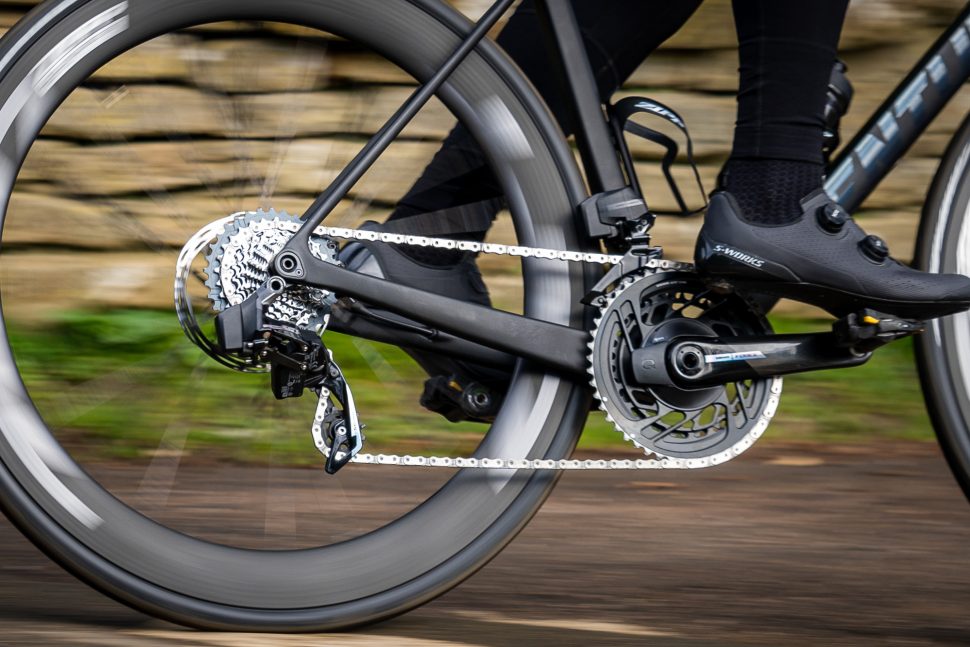Power meters provide cyclists with real-time data, enhance training efficiency, prevent injuries, improve competitive performance, and increase overall riding efficiency.
The Competitive Edge Provided by Power Meters
Measurement of Effort
A significant advantage of this power meter is that it measures your real power output in watts. That way, you are always aware of how much energy you are exerting in real-time. For example, in your usual training, you may discover that you are continuously producing 250 watts. Such numbers are vital in setting realistic workout goals and expectations as well as monitoring how much you have improved or the amount of energy you’ve spent.
Training Efficiency
Cyclists use a power meter through training zones to maximize their time on the bicycle properly. A power zone is a specific range of your power output that correlates to a particular intensity level while riding a bicycle. When worn correctly, power meters ensure that every action moves you towards attaining your performance or fitness goals.
Feedback and Real-time Adjustments
This equipment provides you with feedback at the time of exercising or competition. If while climbing, you realize your power output drops, you adjust the effort. Power meter motivates continuous performance and the need to avoid bad races
Power Translation Trends
Another advantage of using a power meter is that it gives a history of how much energy you have been putting over the ride time. This history indicates facts, for example, for average watts may increase, meaning you have become a stronger cyclist over time.
Racing Insight
The power meter gives you limited time to make strategic decisions during racing occasions. You manage your power output either to ride harder or layoff due to your power output reading as well as the profile of the road. It is a strategy where winners get a pro tip over the pack.
Data-Driven Training
The Impact of Data-Driven Techniques
The arrival of data-driven techniques has transformed the experience of training for all athletes, and sports such as cycling are leading this change. The involvement of Stages power meters is critical as it provides detailed, actionable information that can dramatically boost training capabilities.
Customization Through Data
The level of customization possible with the data from the power meters is unthinkable. Your power output from various situations and times can enable coaches and trainers to produce customized workouts that target your comparative flaws. For instance, if more data illustrates your output begins to fall after approximately 1 hour of a hard effort, they may include a lengthy period at the same effort to make you endure high intensities longer.
Quantifiable and Objective Assessment
As previously said, feeling and fatigue are no longer the only criteria used for assessment. Power meters, especially a Stages power meter, make this criterion quantifiable and objective. The standard here is beneficial: the more orthodox power data you have, the longer and better you can perform.
Importance of Recovery
Recovery is just as necessary as the training itself. By keeping track of how your power data shifts over time, you can quickly comprehend how your body adapts to various training loads and intensities. With this knowledge, recovery methods that allow you to achieve the most benefit from each training without becoming ill can be made.
Advanced Levels of Analysis
Stages power meter offers levels of analysis that are impossible for non-professionals. Tracking your minute improvements and victories may be thrilling.

Injury Prevention
Injury Prevention in Cycling
One of the training aspects that are never taken lightly is injury prevention. Due to the repetitive stress and overuse injury nature of cycling, ensuring that athletes are not overworked or at risk of developing a serious injury is always a priority. A Stages power meter helps cyclists avoid these shortfalls by enabling them to monitor and analyze their riding dynamics, assisting them to prevent injuries.
Monitoring of Training Load
When using a Stages power meter, the exact amount of work done during each session is calculated in watts and TSS. Monitoring such metrics can help prevent rapid adaptation; making high levels of training that are typical to cause fatigue and hence injury less likely.
Balancing Effort Between the Legs
One of the most prevalent causes of injury in cyclists is the development of imbalance in muscle strength and power output between the two legs. A power meter measures asymmetry in power output between the left and the right leg, enabling athletes to implement targeted exercises to correct the weaknesses. This minimizes the likelihood of injury occurring.
Determining Recovery and Rest Periods
One of the key concepts behind preventing injury is recovery. The Stages power meter data help determine optimal rest periods. If performance in terms of power starts to creep downwards in successive days, it is a sign that the athlete is due for a day off to prevent overuse injury.
Refining Cycling Technique
Cycling technique has been a taboo subject in the past. However, a Stages power meter helps athlete’s look at how efficient each and every pedal revolution is. As such, each leg contributes the same amount of power and discomfort, which is a less stressing movement than others, reducing exposure to injury. Therefore, a Stages power meter refines technique.
Predictive Analysis for Injury Prevention
A power meter over time can help predict when an injury is likely to happen before it does. By collecting data over a longer interval, one is able to generate trends that flag reductions in power or increased HR at lower power or even fluctuations in performance. Such predictive insights can help adjust a target before something serious is realized.

Enhancing Cycling Efficiency
Enhancing Recreational Cycling with Technology
Cycling isn’t only about competition and training; it’s a recreational experience that brings immense joy; thanks to manufacturers like Stages, installing a power meter will undoubtedly increase the fun factor. Technology can help to achieve a wider range of experiences and enjoyable riding in the following ways:
Finding Personal Best Riding Zones
Power meters can help a cyclist to find one’s personal best riding zones that one can maintain for a significant amount of time or distance. This knowledge allows one to choose the speed at which one is comfortable and avoid the discomfort of excessive stress to oneself and the bike. Riding for long distances can be made pleasurable in this way.
Data-Driven Performance Enhancement
A pleasure of being data point acquainted, cyclists will notice improvements in their physical abilities. A power meter gives one specific measures of one’s performance that can be seen in riding ability increases; average power output; and increased efficiency, metrics that are highly rewarding and make one strive to improve it.
Optimizing Race Strategy
Pre-race
Assess the course profile, identify your best power outputs from previous races, and develop pre-determined watts targets per section of the race. It might mean maintaining a higher wattage on climbs and more reserved power on flat terrain if a race has several climbs throughout.
Different Terrain
A power meter values consistency throughout all types of terrain. Instead of guessing how well you might be performing due to adrenaline, you can use objective performance data to ensure you do not over-exert on big climbs or push too little on the descents. For example, target a specific wattage, which could be 85% of your FTP on the long climb.
Race Dynamics
One of the beauty of races is the likelihood of anything occurring, for example, breakaways and sprints. The power meter lets you decide when to commit to a break or conserve energy. Whether or not staying up with a break is feasible is determined by continuous real-time feedback on your power and current power.
Managing Fatigue
As the race goes on, fatigue kicks in. It is where the power meter becomes necessary to check if your average power is sufficient to finish the race. Depending on how you are feeling and what the data tells you, this could become the difference between constantly accelerating and bonking or finishing the race strongly.
Post-race Analysis
Examine your power meter data post-race, including which zones were utilized for the period. Determine if any points corresponded with your race plan and how a modified strategy could help you improve. Analyzing your data after the race can help you focus on the next areas of development, from your racing tactics to your base fitness.





